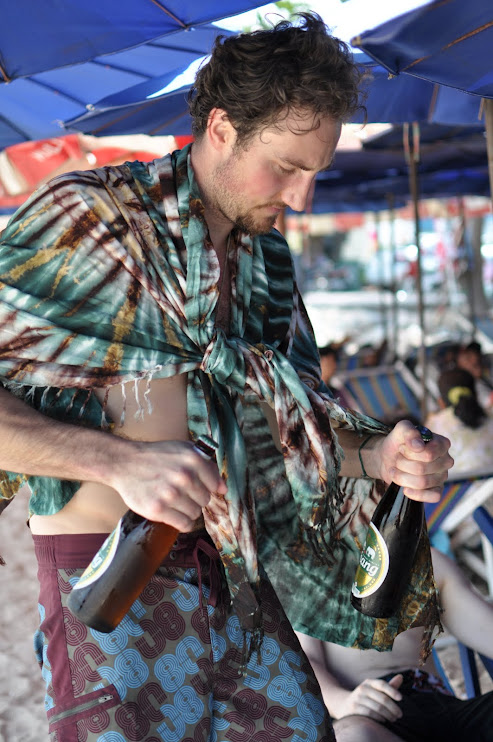In the early morning hours of August 6th, 1945, an industrial Southwestern Japanese port city was unknowingly prepping itself to bleed its way into the history books. Actually, back up a step, if I'm going to be accurate with my language I suppose "vaporize" is a better operating word. The bomb, dropped by the
Enola Gay an American B-29 Bomber
, was the first atomic device ever to be used as a weapon. It exploded about 600 meters above the city instantly killing around 80,000 people. That number, according to the Cooperative Japan-US Research Foundation on Radiation Effects, would effectively double by December of the same year. As many as 250,000 people (survivors) were exposed to significant levels of radiation during the atomic bombing of Japan, and every year, subsequent to explosion, some die of a radiation-related cancer.
Sixty six years, four months, and twenty one days after that atomic shit-storm rained from above, at about the same time in the morning, I arrived in Hiroshima. After a quick cup of coffee (night buses aren't the most comfortable place to sleep, especially if your twice the size of the Japanese standard) I headed for the Peace Memorial Park. The park was designed around the Genbaku Dome (原爆ドーム meaning Atomic dome) which was one of the only buildings left standing after the devastation of the bomb. This fact moves from "remarkable" to "oh, I understand....that's kinda shitty" when you find out that this building was pretty much ground zero for where bomb struck. Instead of experiencing the immensely destructive horizontal shock-wave that toppled the rest of the town, the former concert hall was sheltered in an impact shadow. Though the occupiers of the structure didn't fare so well against the heat, almost instantly sublimating into gas.
 |
| Hiroshima's Genbaku Dome is a gruesome reminder of the day the sky fell. |
All along the river, and throughout the park are many independently financed tributes to those who lost their lives in devastation.
 |
| Here two siblings prepare to release the symbolic dove. On Aug 6th every year doves are released in commemoration. |
 |
| The Children's Peace Monument features a girl holding a giant origami crane, a symbol of health and longevity. |
| At the base of this monument are thousands upon thousands of origami cranes. The tradition was started by a young girl, Sasaki Sadako, who fell ill with radiation related leukemia in 1955. After her diagnosis, the 12 year old began folding these cranes in the hopes that if she reached 1000 she'd be cured. She died before reaching her goal but her classmates took it upon themselves to finish the job. Now it's become a tradition and every year school children from all over Japan lay their colorful creations at the foot of this monument. |
 |
| Strings of paper cranes at the Children's Peace Monument |
 |
| Right in the middle of this clever alignment is the eternal Flame of Peace, which will be extinguished on the day the last nuclear weapon on Earth has been destroyed. |
Primed with all of the somber information above, I expected this to be one of those "educational excursions" with glaring (and possibly shocking) reminders on every street corner. What I found instead was that Hiroshima (outside of the Peace Park) is a bustling modern city, full of spectacular cuisine, friendly people, a network of canals much akin to a Dutch city, and hardly any trace of being atomically panini-ed in the last 70 years.
 |
| The local baseball team, the Toyo Carps, are the six-time champions of Japan's Central League. |
 |
| Hiroshima's close proximity to the Inland Sea means the local food is loaded with fresh seafood. Sardines and oysters are the specialty. |
 |
| Nothing like 焼き牡蠣 (yaki kaki, grilled oysters) for breakfast! |
 |
| Just outside Hiroshima, Iwakuni sports this famous bridge which was built without using a single nail. |
 |
| Hiroshima also plays host to a castle. Although historically is didn't last long- being destroyed only 11 years after it's 1589 construction. |
 |
| This 5-story pagoda towers proudly over Miyajima's Itsukushima shrine. |
In the right light, at sunset Itsukushima is in the running for one of Japan's most beautiful views. Located on an island in Hiroshima bay, high tide here means it's welcoming torii gate is partially submerged below the water-line.














Thanks for the story's and of your travels Matt...was cool ! The Hopeful Wanderer...i like this a lot...all the best to you man in Japan and surrounds...maybe we meet again on the road some time...i always come back sooner or later :-) Peace out...Clint
ReplyDeleteGlad to hear that you're still carrying the fire! I don't doubt for a second that our paths will cross again somewhere down the road.
DeleteMy favorite so far. Very well written. Hugs!
ReplyDeleteThanks for the praise, it feeds my soul.
Delete